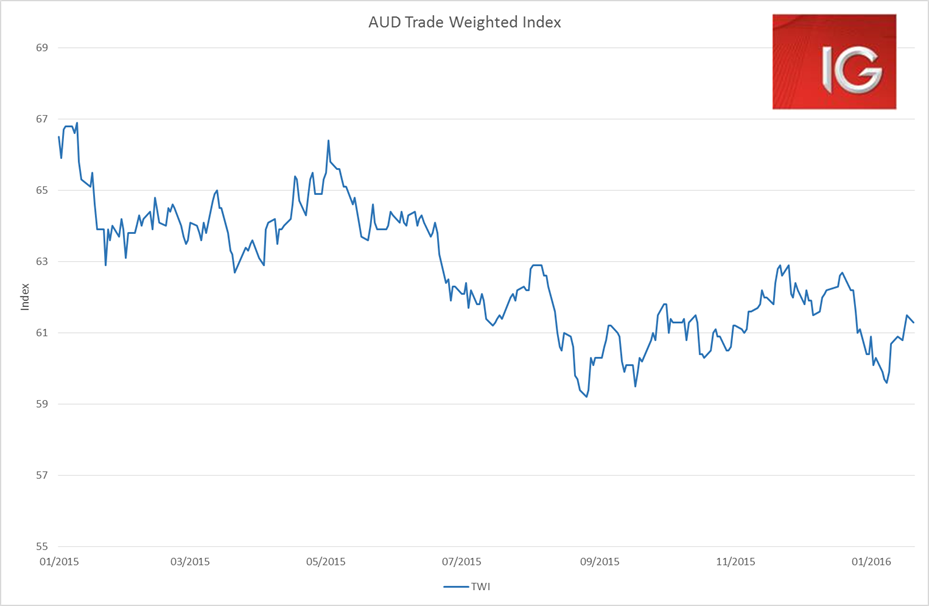The first RBA meeting of 2016 is today. However, unlike the first Tuesday in February 2015, when there were questions of ‘leaking to the press’ to prepare for an unexpected rate cut, 2016 will be a much duller affair. Yet an interesting trading period for the AUD.
Factors impacting the AUD
Australian bond yields have had their biggest rally in six months; ten-year sovereign bonds are currently at 2.62%.
This rate probably does not reflect the IMF, World Bank or the general consensus view on inflation, and the domestic economy for 2016 in Australia - the yield should be higher. The catch for the AUD is the fact Aussie bond yields are a carry trade haven - JPY and EUR are case in points.
AUD – although AUD/USD is at 70 cents, the trade-weighted index rallied in January due to the fact it has a 26.7% weighting to the RMB (see August 2015). A PBoC intervention to the RMB will create another headache for the RBA as trade competition ramps up and will hit the AUD TWI.

International growth concerns – China’s slowdown has to be mentioned in today’s RBA press statement. Every other central bank so far in 2016 has pointed to the fact growth in 2016 is being questioned; the RBA has to mention it. However, how this impacts the AUD remains to be seen, considering the AUD is breaking down as a China quasi-trade.
What will stay the hand of the RBA – AUD positive
Domestic activity is at a five-year high and still expanding – both PMI reads are above 50.
Employment has surprised to the upside and is also showing no signs of falling.
GDP, while below trend, is still growing at a steady pace. It hasn’t yet suffered from private investment slowdowns despite CAPEX figures suggesting it will. The interesting part of the GDP equation to watch is government spending.
2016 is an election year so government spending is being questioned and may need to be capped for Australia to remain AAA rated. Yet an election year normally brings increased spending promises and that is a GDP positive and, in theory, a AUD positive.
Business confidence and conditions expanded in 2015.
Inflation remains stubbornly inside its target trimmed-mean band of 2% to 3%, at 2.1%
The AUD case
The interbank market is pricing one rate cut in 2016 but the earliest chance is not until June.
The Fed funds rate futures are now pricing a ‘one done, all done’ scenario – USD weakness is picking up every day.
Both the ECB and the BoJ are creating a carry trade scenario and Australia is highly attractive to this trade.
China’s economic outlook, while negative, no longer has the same impact on the AUD as it did five-plus years ago, as the Australian economy rotates away from a mining-led economy to services and domestic factors.
Australian exports still lack competitive drive. In a currency sense, a weaker currency is needed.
Three of biggest importers of Australian goods remain under economic clouds, likely meaning lower cross rates - RMB, JPY and KRW.
AUD is still traded as a quasi-play on Asian-Ems.
My focus trade is for a long call on AUD in the short term:
The RBA is likely to signal that rates are unlikely to move in the first quarter of 2016.
The USD is more likely to weaken in the coming weeks as Fed bets ramp up.
The Japanese carry trade is now likely to ramp up.
My 2016 base case is still for a weaker, or at least a flat AUD. However, interim factors suggest a long call is the correct trade. AUD/JPY looks like it could retest the December high of ¥90. On a daily chart, it has not hit overbought levels and the momentum in the trade is strong.
